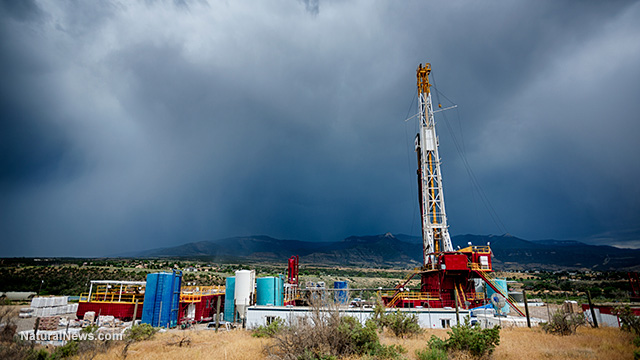North Dakota's murky situation: 1-in-3 fracking wells in the state has had a leak... 9,700 wells in total
Thursday, May 19, 2016 by: Daniel Barker
Tags: fracking wells, leaks, North Dakota

(NaturalNews) The environmental damage and subsequent health risks caused by the fracking industry are far greater than previously thought, according to a recent Duke University study that examined fracking spills in North Dakota.
In North Dakota, around 9,700 oil and gas wells have been drilled in the past decade, and spills have been reported at more than one of every three drilling sites.
The Duke research team found that large amounts of radioactive materials, heavy metals and other toxins have contaminated widespread areas of the state.
From Eco Watch:
"Some rivers and streams in North Dakota now carry levels of radioactive and toxic materials higher than federal drinking water standards as a result of wastewater spills, the scientists found after testing near spills. Many cities and towns draw their drinking water from rivers and streams, though federal law generally requires drinking water to be treated before it reaches peoples' homes and the scientists did not test tap water as part of their research.
"High levels of lead—the same heavy metal that infamously contaminated water in Flint, Michigan—as well as the radioactive element radium, were discovered near spill sites. One substance, selenium, was found in the state's waters at levels as high as 35 times the federal thresholds set to protect fish, mussels and other wildlife, including those that people eat."
Fracking waste toxins will be around for 'millennia'
Nearly 4,000 oil and gas wastewater spills in North Dakota have dumped millions of gallons of poisonous sludge into the soil and water. This wastewater contains toxins that will remain for "millennia," unless "unprecedented" cleanup efforts are made.Nancy Lauer, lead author of the study, said:
"Unlike spilled oil, which starts to break down in soil, these spilled brines consist of inorganic chemicals, metals and salts that are resistant to biodegradation. They don't go away; they stay. This has created a legacy of radioactivity at spill sites."
Radium 226, one of the radioactive contaminants found in the spill sites, has a half-life of 1,600 years.
Lack of standards and oversight
Oversight of the fracking industry is inadequate, partly due to federal laws that exempt fracking waste from its jurisdiction:"The sheer volume of waste generated by the industry—particularly from the type of high volume horizontal hydraulic fracturing used to tap shale oil and gas—has often overwhelmed state regulators, especially because federal laws leave the waste exempt from hazardous waste handling laws, no matter how toxic or dangerous it might be, under an exception for the industry carved out in the 1980's."
North Dakota's state inspectors are short-handed – each inspector is personally responsible for 500 wells – and the picture is similar in other states.
The extent of fracking operations in the United States is enormous. From the U.S Department of Energy:
"More than 4 million oil and gas related wells have been drilled in the United States since development of these energy resources began nearly 150 years ago. At least 2 million of these have been hydraulically fracture-treated, and up to 95 percent of new wells drilled today are hydraulically fractured, accounting for more than 43 percent of total U.S. oil production and 67 percent of natural gas production."
The bottom line is that the fracking boom happened so quickly, and with so little regulation, that we are only beginning to understand the potential health and environmental costs. The fracking industry pulled a fast one on the American people, and it appears that we will be paying the price for centuries to come.
Sources:
EcoWatch.com
DrCInfo.org[PDF]
Energy.gov
WashingtonPost.com
Science.NaturalNews.com
Fracking wells at FETCH.news
Get independent news alerts on natural cures, food lab tests, cannabis medicine, science, robotics, drones, privacy and more.
Take Action: Support Natural News by linking to this article from your website
Permalink to this article:
Embed article link: (copy HTML code below):
Reprinting this article:
Non-commercial use OK, cite NaturalNews.com with clickable link.
Follow Natural News on Facebook, Twitter, Google Plus, and Pinterest
- TAKE IT DOWN Act advances in Congress amid free speech concerns
- Gardening tips: 15 Simple tricks to double your garden’s yield this season
- Survival 101: Dangerous places to avoid when disaster strikes
- Nature’s arsenal: How plant compounds power military survival and healthcare in crisis
- Kawasaki unveils rideable ROBOT HORSE powered by hydrogen
- DOJ and ATF kill Biden’s “Zero Tolerance” firearms dealer policy
- Amazon's Kuiper satellite launch delay highlights uphill battle against Musk's Starlink
- Hospital staffers sound alarm after 10 nurses were diagnosed with BRAIN TUMORS
- Barley: A nutrient-dense ancient grain with modern benefits
- Criminal referral requests filed against Fauci and top COVID officials in seven states
- “Prepare Tribe: Prepare, Protect, Provide” on BrightU: How to build a disaster-proof shelter in the middle of nowhere
- New studies ignite debate: Fluoride linked to autism and ADHD, prompting calls for policy reassessment
- Germany prepares students for war amid growing security concerns
- Rafael Medoff explores the role of Jabotinsky in the rise of Revisionist Zionism in “Militant Zionism in America”
- Sovereign debt paradox: U.S.-China mutual holdings fuel geopolitical tensions
- Yoga and autism: A science-backed look at how a simple practice is transforming behavior and movement in children with ASD
- POLL: U.S. support for Israel drops to lowest level in decades amid Gaza War
- Widespread social and economic unrest: Steve Quayle issues urgent financial warning of imminent asset collapse in new interview with Mike Adams
- Tulsi Gabbard leads charge against the Biden regime’s global censorship of the 'Disinformation Dozen'
- Fauci is back in the limelight, and he’s busy promoting a future COVID or FLU pandemic
- Aerosolized bioweapons? Strange “diploid biomasses” falling out of the sky in Florida captured under the microscope
- Analysis: The coming economic collapse, a mass uprising and Trump's three secret weapons to halt the growing revolt
- Widespread social and economic unrest: Steve Quayle issues urgent financial warning of imminent asset collapse in new interview with Mike Adams
- Kiss Your Genetic Privacy Good-Bye! 23andMe Gets Green Light to Sell Your Intimate Genetic Details to Anyone They Want
- Tulsi Gabbard takes aim at censorship: Justice for the ‘Disinformation Dozen’
- Mike Adams releases country western hit single: Goin’ Back in Time is Comin’ Home
- U.S. lawmakers investigate Meta over alleged China collaboration
- CLOT SHOT PLANDEMIC UNFOLDING: Fibrous, rubbery clots caused by covid injections have prion-like seeding activity
- Chemtrails unveiled: How the CIA and Big Business are manipulating the weather for profit
- How Israeli military-connected corporations are secretly controlling your online privacy
- European Court of Justice: Healthcare professionals who promoted or administered COVID-19 vaccines are CRIMINALLY LIABLE for any harm caused
- DEATH by VACCINE or face PRISON time: Canadian Freedom Convoy leaders CONVICTED for protesting forced vaccination during the Covid Plandemic
- Defunding DEADLY mRNA jabs: Government funding for mRNA technology being scrutinized and sidelined until proven "safe and effective" for real
- Federal employees whine over DOGE's new directive requiring them to do a 5-point summary of weekly accomplishments
- U.S. approves new Russian ambassador as diplomatic thaw continues
- Curcumin’s ancient healing power supercharges muscle recovery, and its effects are compounded with anti-inflammatory foods and supplements
- Newly released JFK files reveal Pentagon's role in creating Lyme disease and covid in the same lab
- Analysis: The coming economic collapse, a mass uprising and Trump's three secret weapons to halt the growing revolt
- Mike Adams releases country western hit single: Goin’ Back in Time is Comin’ Home
- Aerosolized bioweapons? Strange “diploid biomasses” falling out of the sky in Florida captured under the microscope
- Kiss Your Genetic Privacy Good-Bye! 23andMe Gets Green Light to Sell Your Intimate Genetic Details to Anyone They Want
- Dr. Mike Yeadon releases 15-minute testimony - WATCH - about genocidal intent of COVID “vaccines”
- Trump reverses course on Gaza plan, says “nobody is expelling Palestinians”
- MEDICAL BOMBSHELL: FDA admits Covid mRNA 'Vaccines' CAUSE CANCER
- European Court of Justice: Healthcare professionals who promoted or administered COVID-19 vaccines are CRIMINALLY LIABLE for any harm caused
- The Health Ranger releases “Vaccine Zombie” song and music video, using AI-animated zombies for the music video
- 5 Simple steps to boost your brainpower: How to strengthen executive function in a distracted world
- A lack of integrity in Academia: Harvard professor found GUILTY of fraudulent research to promote CRT theory
- Federal employees whine over DOGE's new directive requiring them to do a 5-point summary of weekly accomplishments
- EPA advisor admits the agency is funneling billions to climate groups ahead of Trump’s return to White House
- California's social media censorship law struck down: A victory for free speech or a threat to online safety?
- Space war brewing? Russia threatens to destroy Starlink satellites
- Survival 101: Effective EMF blocking techniques
- Rep. Nancy Mace introduces bill to ban biological males from female facilities on federal property
- Red Cross issues warning to stop blood plasma donations from vaccinated people
- Scientists confirm: GENIUS brain function can be spontaneously unleashed in humans without any apparent cause
- EPA advisor admits the agency is funneling billions to climate groups ahead of Trump’s return to White House
- HYSSOP: What research reveals about the health benefits of this ancient holy herb
- Two containers with completed ballots fall out of truck in Florida
- Newly released JFK files reveal Pentagon's role in creating Lyme disease and covid in the same lab
- Global leaders unite to clamp down on “misinformation” with UN-backed Cascais Declaration
- BREAKING: 2025 NDAA authorizes mandatory military draft of WOMEN across America… as Pentagon pursues global NUCLEAR war with both Russia and China at the same time
- Michael Yon warns of a ZIONIST TAKEOVER in Trump’s second administration
- Ozempic and Wegovy weight loss drugs are injectable LIZARD VENOM PEPTIDES that may unleash a devastating wave of organ failure… side effects align with symptoms of SNAKE BITES
- The Health Ranger releases “Vaccine Zombie” song and music video, using AI-animated zombies for the music video
- Mike Adams releases country western hit single: Goin’ Back in Time is Comin’ Home
- BOMBSHELL: DNA testing kits are a SCAM to develop ethnic-specific bioweapons
- Israeli soldiers accused of even more torture and abuse in the West Bank
- These 13 countries just signed an agreement to engineer a global FAMINE by destroying food supply
- NASA admits that climate change occurs because of changes in Earth’s solar orbit, and NOT because of SUVs and fossil fuels
- Fully vaccinated about to see “tsunami” of illness and death, warns virologist
- RFK Jr. clears key hurdle: Sen. Susan Collins backs controversial HHS nominee, signaling a new era for health policy
Science News & Studies
Medicine News and Information
Food News & Studies
Health News & Studies
Herbs News & Information
Pollution News & Studies
Cancer News & Studies
Climate News & Studies
Survival News & Information
Gear News & Information
News covering technology, stocks, hackers, and more



"Big Tech and mainstream media are constantly trying to silence the independent voices that dare to bring you the truth about toxic food ingredients, dangerous medications and the failed, fraudulent science of the profit-driven medical establishment.
Email is one of the best ways to make sure you stay informed, without the censorship of the tech giants (Google, Apple, Facebook, Twitter, YouTube, etc.). Stay informed and you'll even likely learn information that may help save your own life."
–The Health Ranger, Mike Adams












































